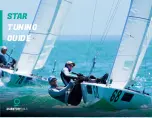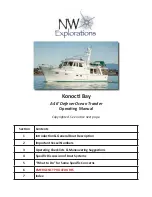
a. Avoid sparks and open flames near battery. It may explode.
b. Keep battery poles protected from any shortcut or contact with any metal things.
c. Turn off the engine when inspecting or servicing the battery.
d. Never keep battery close to fuel tank, filler or fuel system elements.
13. AVOID any contact of the inflatable tube with any sharp objects or aggressive liquids or
chemicals.
14. INSPECT AND MAINTAIN STEERING SYSTEM: an improperly maintained system
may fail, causing sudden loss of control.
15. AVOID THE RISKS OF EXPLOSION OR FIRE HAZARDS: Ensure your fuel system is
in a good with no leaks or smell, and maintain it properly.
16. AVOID SMOKING ON BOARD.
17. IF FUEL HAS SPILLED ON THE FLOOR: wash off with water. Stop operating the boat
if you discover any fuel leak or fuel smell until you find and fix the problem
.
c) Mooring and towing:
• MOORING: use the buoyancy tubes' lateral D-rings. When moored, the self-bailers
should remain open to drain the rain water.
• TOWING: fully inflatable boats should always be towed using a bridle. Use the 2
lateral D-rings (fixed on the buoyancy tubes) made for this purpose. For rigid inflatable
boats (RIB), use a single line attached to the mooring ring.
CAUTION
1. Towing must be done at low speed (not more then 10 km/h) and in good weather
conditions with no waves.
2. Towing boat must be supervised at all time of towing
.
d)
Lifting the boat
:
To lift boat and place it on davits, use the factory installed lifting eyes only, or have
them installed by your Dealer if the boat is not equipped. Use only certified and rated
lifting slings, appropriate for your boat and motor weight.
Summary of Contents for VIKING V Series
Page 1: ......






































